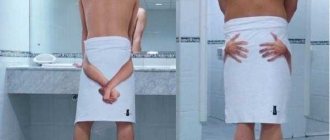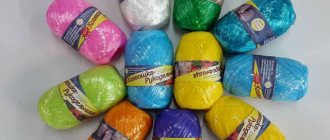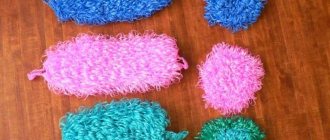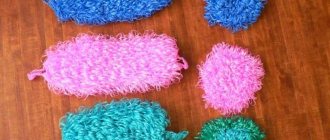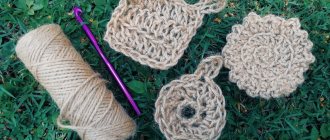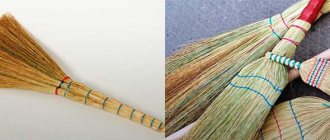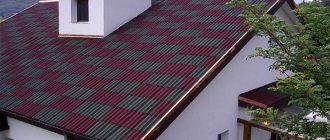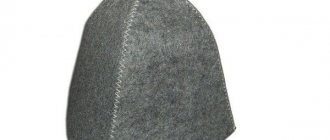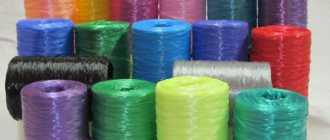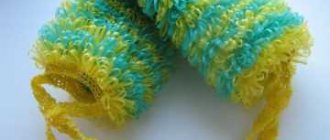Felting a hat will give you the opportunity to reveal not only your creative abilities, but also bring things of unusual beauty to your wardrobe
Felting is an old craft that was widely used in creating wardrobe items. In the old days, not a single fair was held without sales or purchases of felted items. There are two felting techniques: dry and wet. For wardrobe items use wet, for bulky items - dry. Wet felting a hat involves compacting the material to form a single fiber.
Basic felting hat pattern for beginners
The pattern is not difficult. Even beginners can handle this, but it will be much better if you watch a special training video before doing so.
The first thing you need to do when cutting a hat for felting is to measure the circumference of your head.
Let's look at how to make a template step by step:
- First you need to make a calculation. For this we need the size of the head. We measure the circumference of the head and the length from the crown to the neck. We divide the resulting values in half and allocate a percentage for the shrinkage of the material.
- We determine the intersection point and withdraw the resulting amount from it. We get 4 points (half of the whole).
- We connect these points with a dotted line, maintaining a bell shape.
- Add the shrinkage percentage. 30% is enough. The percentage is calculated from the original data.
- We connect the resulting pattern with lines. When determining the percentage, pay attention to the type of wool. Its thickness directly affects the shrinkage of the material. The denser the material, the less it will settle.
This pattern is a help for beginners.
Features and Benefits
Among nonwoven materials, a distinction should be made between felt and felt, although both materials are similar. Felt can be either natural from the fluff of rabbits and goats, or from synthetic fibers. Compared to felt, felt is a more flexible, soft and lightweight material. Although these characteristics apply more to felt and factory-produced felt. Craftsmen who felt by hand create felt of varying densities and thicknesses, from translucent webs to fabric several centimeters thick.
An important feature of felt hats is the use of exclusively natural materials in their production, since only 100% sheep wool can be felted. In such a hat it is not hot indoors and not cold in the cold. This means you don’t need to take it off on public transport or in a store, which will allow you to preserve your hairstyle and the intended image as a whole. Felt is an excellent thermostat that does not allow moisture to pass through, but absorbs it like a sponge. The felted hat is not afraid of snow and is not blown away by the wind. At the same time, the hat is lightweight, you can roll it up and put it in your purse without fear of ruining it.
A felted hat is a bright and unusual accessory that will not let you go unnoticed. Therefore, when choosing a felt hat, you should carefully consider your overall look.
Step-by-step felting of a bathhouse cap: master class from professionals
For bath lovers, an original cap will be an excellent attribute in a hot sauna. Wet felting is great for wardrobe items. Consider a master class on making a bath cap.
To work you need:
- Material for pattern;
- Wool;
- Polyethylene;
- Nylon fabric;
- Warm soapy liquid;
- Sanding machine, if available;
- Gloves for work.
We make a pattern on paper. The hat will be in the shape of a bell. We focus on size 56. Based on this, the width is 44 cm and the height is 28 plus 6 cm to create a semicircle. Let's make another pattern on polyethylene.
We put the polyethylene under the paper and begin to lay out the wool. Let's choose the main shade and start working from the top of the head. Thin strands will make approximately 6 rows.
The next step is to wet press the pattern. Place a nylon cloth on top of the felt ball and moisten it with a soap solution. It will be convenient to use a spray bottle.
We begin to wipe the future hat, moving from the central part to the sides. When the wool lies evenly, you can begin to make circular movements, lifting the nylon fabric. These manipulations must be performed until the felt stops stretching.
We apply a film pattern to the product. It is necessary to press down the template well. Carefully tuck any protruding fibers behind the film.
Next you need to place the second ball. Now starting from the bottom and moving to the top. Next you need to carry out the same manipulations as with the first layer. Cover with a nylon cloth, moisten and smooth out a little. Then the hat blank must be turned over. Carefully tuck any protruding fibers behind the film.
Now you need to make a cross layer of wool. On the sides the villi can boldly protrude, while at the top and parallel to it a straight line should form.
The bath cap can be of any design, the main thing is to follow the instructions, then the result will not be long in coming
The thickness of the wool layer should be the same in both balls.
Then we again cover the cross layer with a cloth, spray it with soapy water, and rub it. Turn over and remove any protruding fibers.
On the other side the process is similar. Then repeat the cross layer on both sides. Total of 4 layers in total on each side.
The wool needs to be pressed. To do this, you can use a special machine or work manually. There is no need to process the edges.
Monitor the moisture content of the product. In case of high humidity, remove excess water with a towel.
Next you need to roll the hat onto a stick and roll it on a bamboo mat. The procedure will take 5 minutes, after which the product is straightened and the felting side is changed. You need to allocate 20 minutes for this. During surgery, smooth out any creases. After this, the cap must be turned out and the procedure repeated. The product resembles a cap.
It’s time to add a soap solution to well-felted wool. It is better to work with gloves. You need to crush the product thoroughly.
While felting, straighten the craft on both sides.
When the product begins to shrink, you need to put the hat in hot water and wrinkle it a little. Next, lower the product into cold water. Repeat this contrast again. This is an important measure so that the hat gets used to changes in temperature in the bathhouse. When finished, rinse the product in warm water and dry with a towel.
The still wet hat must be put on the workpiece and given the desired shape.
If desired, you can create a woolen decor. You can also make the lining on silk.
How to calculate the size
The first is measurements for the template. Templates for felting hats are a kind of skeleton of the product. They are easy to make, but under the influence of hot water the material shrinks, and therefore, when making a hat from wool, there is a risk of getting something that will then be impossible to use.
How to correctly calculate the size of a hat when wet felting? Wool shrinks by a third, so the measurement results are multiplied by 1.3. You will need two measurements: the volume of your head plus the distance from the back of your head to the bridge of your nose.
Eg:
Head volume – 54 cm.
(To measure the volume of the head, we run a centimeter tape in front along the line of the eyebrows, and in the back along the occipital protuberance).
Height – 42 cm.
The numbers are divided in half.
A pattern is drawn with a width of 27 cm (54/2), a height of 21 cm (42/2). The upper part is rounded, and 10 cm is added from below for the future lapel. Half the head volume is multiplied by the shrinkage factor and rounded up. It turns out 35 cm. The difference between 35 and 27 is added for insurance. 35-27 = 8. The allowance on all sides is 4 cm (8/2) and on top 8-10 cm to decorate the crown.
Ready-made patterns for felting hats can be found on the Internet and you can choose the design you like.
A template is cut out of the substrate or plastic film. An untouched train remains at the bottom so that the fields of the future accessory do not fall into one.
An interesting idea - felting a hat with ears
The felting technique can be used when creating a hat with earflaps. You can also create children's versions of the product with cat ears.
Let's consider an interesting option for hats with ears. For work we will need:
- Wool is the main material;
- Material for pattern;
- Soapy water;
- Polyethylene;
- Sanding machine (if available).
The system for felting a hat with ears is no different from a regular hat: we apply several layers of wool, thoroughly wetting and compacting the pattern on both sides
The usual pattern involves a circle in the shape of the head. For hats with ears, you need to cut out an ellipse. We take head circumference data, but stretch the circle. The correctness of the calculation can be easily checked using a thread. Use it to measure the circumference of your head and compare it with the drawn ellipse.
The most important part of the pattern is drawing the ears. We draw them in a circle, taking into account that the ear deviates from the center if you look at the head profile drawing.
At the end of intensive felting, we give the product a contrasting bath, after which we rinse the hat and allow it to dry on the workpiece. Malachai is ready to use.
Features and Benefits
Among nonwoven materials, a distinction should be made between felt and felt, although both materials are similar. Felt can be either natural from the fluff of rabbits and goats, or from synthetic fibers. Compared to felt, felt is a more flexible, soft and lightweight material. Although these characteristics apply more to felt and factory-produced felt. Craftsmen who felt by hand create felt of varying densities and thicknesses, from translucent webs to fabric several centimeters thick.
An important feature of felt hats is the use of exclusively natural materials in their production, since only 100% sheep wool can be felted. In such a hat it is not hot indoors and not cold in the cold. This means you don’t need to take it off on public transport or in a store, which will allow you to preserve your hairstyle and the intended image as a whole. Felt is an excellent thermostat that does not allow moisture to pass through, but absorbs it like a sponge. The felted hat is not afraid of snow and is not blown away by the wind. At the same time, the hat is lightweight, you can roll it up and put it in your purse without fear of ruining it.
A felted hat is a bright and unusual accessory that will not let you go unnoticed. Therefore, when choosing a felt hat, you should carefully consider your overall look.
Felting a men's hat for everyday wear
Wool hats retain heat well and regulate humidity. For a fisherman husband, such a gift will be a real salvation on winter fishing.
In the appropriate store you need to buy wool of the desired color and density.
For felting a men's hat, it is better to choose practical dark or gray wool options
The set of tools remains the same. We will need:
- Wool;
- Polyethylene;
- Soapy liquid;
- Felting machine (if available);
- Pattern paper;
- Nylon fabric.
The sequence of work and technique is maintained. We measure the circumference of the head and make a pattern. Next, we place the felt in several balls and knead it thoroughly, spraying it with soapy water.
After repeating the manipulations on both sides, we begin felting. The process will take about an hour. After this, we wash the product and leave it to dry on the workpiece.
In Georgia, woolen hats are considered a traditional headdress for men. This wardrobe item can be found in every Georgian.
Models. Color and print
Most often you can find felt animal hats. Stylized owls and foxes, raccoons and cats will be an excellent addition to a youth's informal wardrobe or will highlight mother and baby on the playground if the choice falls on a family look. Funny ears, horns and faces will appeal to children, teenagers, anime lovers, and will also cheer up everyone who treats fashion and themselves with humor.
Beanie hats are made from thinner felt. The folds on the caps are not draped, but are created by the craftsman during the felting process. The trend of the coming season is beanies with a lowered crown, which look more voluminous compared to the classic model, which is important when shaping the silhouette as a whole. After all, in a tight-fitting hat, the head may seem disproportionately small in relation to the figure in voluminous outerwear. Felt beanies, delicate, feminine, warm, will go well with a fur coat and winter coat, quilted or woolen. Designers suggest combining them with stoles and shawls made of thinner felt of the same color as the hat.
Felt hats as art objects! Here there is room for the imagination of the masters to run wild. After all, with the felt technique you can create not only on a plane, but also in three-dimensional space. Hats turn into voluminous flowers on the head, fields, meadows, waves... Such things are unique, and even if desired, the author is unlikely to be able to create an exact copy.
Often felting masters - felt makers - create a one-of-a-kind canvas, mixing textures, textures and colors, like an artist using oil paints on canvas. The result will not leave anyone indifferent. The hat is an art object suitable for truly creative and daring people and will fit well into the boho style.
If you want to express your own ideas in an unusual hat, then you can place an order with a master and jointly think through a project that will be brought to life by a professional. Or make a hat with your own hands using the wet felting method. To do this, you will need wool, water, soap and... hands that are laid out, and then rubbed for a long time, minutes, and stroked this wool. Perhaps you will be fascinated by the process itself, because it is not for nothing that this type of needlework has so many fans and admirers at the present time.
Felt hats and bonnets will be very popular in the coming season. The catwalk presented a wide variety of hats made of non-woven materials: berets and bowlers, fedora hats and cloche hats. Preference should be given to soft shades - lilac, gray, rich blue. Felt hats decorated with luxurious embroidery, metal rivets, and voluminous abstractions made of yarn look very impressive.
The favorite headdress of Parisian women, the beret, can also be made using the felting technique. This model of headdress often appears in the collections of famous designers and promises to return to fashion for a long time. The beret is suitable for girls of a fragile build with graceful features. The beret models that are relevant for the coming season are made in pastel colors - beige, light grey, pale pink and turquoise.
Fashion trends
A felted hat is a unique handmade product. Possessing it is a great and warm happiness, and making it yourself is a skill worthy of praise. Fashion influences felted hats, and now classic hats acquire a youth style, become modern and very fashionable.
Georgian felt hat
The Georgian or Svan hat personifies the rich flavor of Georgia. In this country they are sure that such a hat is a talisman, a priceless gift and simply a universal thing.
The svanka has a round shape and sits loosely on the head, thanks to which it is not hot and, as Georgians say, headaches and the stress of a hard day go away.
Fashion trends have adopted the classic style of the Georgian national hat. Today this original model is complemented by a felt visor, flowers, horns and other decorations.
Hat Rose
Among modern models, a hat with delicate draperies in the shape of a rose stands out clearly. The process of its manufacture includes the technique of wet felting. At the last stage, the crown of the cap is twisted, creating “rose petals”. On the reverse side, the petals are securely reinforced with stitches, so the model will not lose its presentable appearance for a long time.
The felt hat Rose goes perfectly with a romantic look and will be an elegant addition to a coat or fur coat.
Watermelon hat
But an original Watermelon bathhouse hat can be an option for a gift for yourself or your loved ones. It can be done in two solutions:
- half a watermelon with rind;
- red watermelon with seeds.
The first option will be created using the wet felting technique, while the second includes a combination of methods. Thus, the red base of the cap is created in wet felting, and the seeds are later attached using a dry technique using a special needle.
As a gift, the Watermelon hat is suitable for men and women, because it looks bright and very creative, and handmade makes the gift unique.
With horns
British artist Barbara Keel became the author of stylish hats with horns. Using the wet felting technique, she creates hats with sheep, deer and other horns. Bright photographs of her family wearing handmade hats are blowing up the Internet and causing a lot of people to want to copy such models.
Well, it’s not difficult to recreate the model, because it is made like an ordinary felt hat, and later the horns are attached to it.
The model of a felt hat with horns will be an original option for youth casual style, will conquer extravagant natures and simply create a fashionable New Year's look with magical transformations.
With ears
Another model of a hat, made similarly to the model with horns, is a model of a felted hat with ears. The ears of a seductive cat on a “swanka” style hat, complemented by a modest visor, look interesting and sexy.
Models. Color and print
Most often you can find felt animal hats. Stylized owls and foxes, raccoons and cats will be an excellent addition to a youth's informal wardrobe or will highlight mother and baby on the playground if the choice falls on a family look. Funny ears, horns and faces will appeal to children, teenagers, anime lovers, and will also cheer up everyone who treats fashion and themselves with humor.
Beanie hats are made from thinner felt. The folds on the caps are not draped, but are created by the craftsman during the felting process. The trend of the coming season is beanies with a lowered crown, which look more voluminous compared to the classic model, which is important when shaping the silhouette as a whole. After all, in a tight-fitting hat, the head may seem disproportionately small in relation to the figure in voluminous outerwear. Felt beanies, delicate, feminine, warm, will go well with a fur coat and winter coat, quilted or woolen. Designers suggest combining them with stoles and shawls made of thinner felt of the same color as the hat.
Felt hats as art objects! Here there is room for the imagination of the masters to run wild. After all, with the felt technique you can create not only on a plane, but also in three-dimensional space. Hats turn into voluminous flowers on the head, fields, meadows, waves... Such things are unique, and even if desired, the author is unlikely to be able to create an exact copy.
Often felting masters - felt makers - create a one-of-a-kind canvas, mixing textures, textures and colors, like an artist using oil paints on canvas. The result will not leave anyone indifferent. The hat is an art object suitable for truly creative and daring people and will fit well into the boho style.
If you want to express your own ideas in an unusual hat, then you can place an order with a master and jointly think through a project that will be brought to life by a professional. Or make a hat with your own hands using the wet felting method. To do this, you will need wool, water, soap and... hands that are laid out, and then rubbed for a long time, minutes, and stroked this wool. Perhaps you will be fascinated by the process itself, because it is not for nothing that this type of needlework has so many fans and admirers at the present time.
Felt hats and bonnets will be very popular in the coming season. The catwalk presented a wide variety of hats made of non-woven materials: berets and bowlers, fedora hats and cloche hats. Preference should be given to soft shades - lilac, gray, rich blue. Felt hats decorated with luxurious embroidery, metal rivets, and voluminous abstractions made of yarn look very impressive.
The favorite headdress of Parisian women, the beret, can also be made using the felting technique. This model of headdress often appears in the collections of famous designers and promises to return to fashion for a long time. The beret is suitable for girls of a fragile build with graceful features. The beret models that are relevant for the coming season are made in pastel colors - beige, light grey, pale pink and turquoise.
Stylish looks
The male half will not be left without attention either. They even have stylized hats, for example, the eagle owl hat. It goes great with a jacket and parka with a fur collar or hood. For those with conservative views, felted hats with earflaps will suit them. An interesting option is the helmet model. This exclusive headdress is comfortable to wear and provides excellent protection from the cold.
You can create a fashionable look using designer kits. Stylish, bright, environmentally friendly material harmonizes perfectly with drape fabric. The style of the coat itself can be different: classic, oversized or men's cut. The main emphasis is color combinations. The light gray shade goes well with mustard yellow, and the cocoa color with baked milk. The sports jacket will be complemented by a felt beanie hat, and a snood or bactus scarf can be used as a decorative element. The dried bactus scarf can be worn separately; it goes well with a knitted dress and high boots.
When creating an image, do not neglect felt boots. The modernized models look very advantageous when paired with a cap of the same ornament. The stole complete with the bag harmonizes very nicely. Felt products add a refined touch to the wearer's image, emphasizing her refined taste.
